The story of the Thompson family coming to Oregon in 1882
COMING TO OREGON
by
Mona Hyler Waibel
All photos are from the personal collection of Mona Hyer Waibel.
Use of them for commercial purposes is prohibited without her permission
![]()
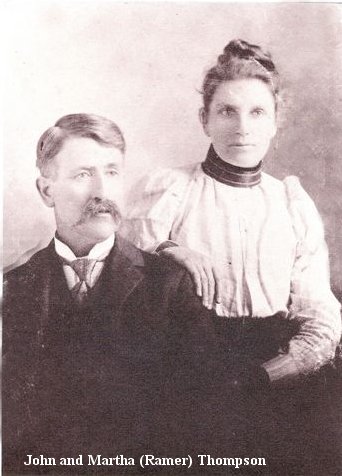 In the year of
1882. It was a
simple fact: John and Martha Ramer Thompson knew they needed to sell their farm
and leave their home in
Illinois. Pollution of the water supply made the
environment unsafe for the children. One
out of four babies died. Martha, 23, had lost another infant from summer
complaint, and older adults were suffering from “tuberculosis”. John, 29, decided to head out to
Oregon where he had been told the
water and air were pure and there was much fertile soil available for raising
gardens. Ample rainfall and temperate
climate all were important for crops and gardening. Word from relatives, the Riggs family, who
were settled in the Sweet Home Valley, told them of plentiful herds
of game and also berries that grew wild on the vines, honey for the finding, and
wild nuts. Martha and John felt the
problems with the local Indians were on the wane and they would be safe in this
valley. They invited John’s sister Phoebe and family to join them. Someone was
waiting and knew the way to Oregon.
Martha’s prayer: Dear
Lord, please give me a mind unafraid to travel, though the trail be not
blazed.
In the year of
1882. It was a
simple fact: John and Martha Ramer Thompson knew they needed to sell their farm
and leave their home in
Illinois. Pollution of the water supply made the
environment unsafe for the children. One
out of four babies died. Martha, 23, had lost another infant from summer
complaint, and older adults were suffering from “tuberculosis”. John, 29, decided to head out to
Oregon where he had been told the
water and air were pure and there was much fertile soil available for raising
gardens. Ample rainfall and temperate
climate all were important for crops and gardening. Word from relatives, the Riggs family, who
were settled in the Sweet Home Valley, told them of plentiful herds
of game and also berries that grew wild on the vines, honey for the finding, and
wild nuts. Martha and John felt the
problems with the local Indians were on the wane and they would be safe in this
valley. They invited John’s sister Phoebe and family to join them. Someone was
waiting and knew the way to Oregon.
Martha’s prayer: Dear
Lord, please give me a mind unafraid to travel, though the trail be not
blazed.
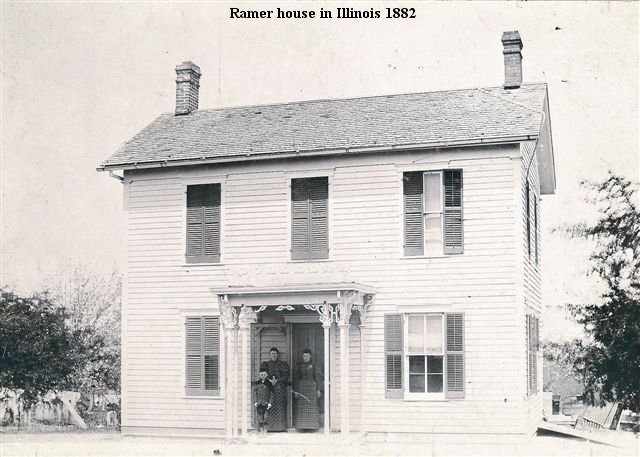 With discussions of leaving
her family behind, petite Martha appeared strong. But Henry and Rosannah Ramer were concerned they would never see their
daughter again. The prominent Ramer family had a fine two-story home and
finances were good. The Ramer and Thompson families, who were well established
in Illinois, did not
want the two younger couples to leave their homes in Illinois. Probably the
grandchildren would grow up without knowing any grandparents. Each discussion brought Mrs. Ramer quietly to
tears. Martha visited her infant son’s grave once more before departing, and
prepared three year old Lettie Pearl for this trip.
With discussions of leaving
her family behind, petite Martha appeared strong. But Henry and Rosannah Ramer were concerned they would never see their
daughter again. The prominent Ramer family had a fine two-story home and
finances were good. The Ramer and Thompson families, who were well established
in Illinois, did not
want the two younger couples to leave their homes in Illinois. Probably the
grandchildren would grow up without knowing any grandparents. Each discussion brought Mrs. Ramer quietly to
tears. Martha visited her infant son’s grave once more before departing, and
prepared three year old Lettie Pearl for this trip.
Martha packed her trunks with many warm quilts her mother and grandmother had handmade with loving stitches. She also packed the things she felt she could not buy in this new land. Margaret Ramer, Martha’s sister, made several lace collars for this trunk and vowed to follow her to Oregon. The women folk made traveling suits for both Lettie and for Martha.
Now was the time for John and Martha to sell their household belongings to fund their food costs traveling to the Oregon Territory. Printed flyers were made and posted in nearby communities telling of the properties that John was selling. John kept his violin, that he lovingly called the “fiddle.” John had carefully counted his money and planned for traveling fares along the way; he expected to buy meals too. The money they made from their sale was tucked away.
It was early in 1882 when the family left Illinois and headed for an adventure in a land far away. During these times, thousands left the Midwest and headed to Oregon and California to claim free land. John’s sister, Phoebe Thompson Nichols, husband Joshua, and two small sons Andy and Will, joined John and Martha for the journey to Oregon. The Nichols merely wanted to try a new environment. There were glowing reports about Oregon and good land was available.
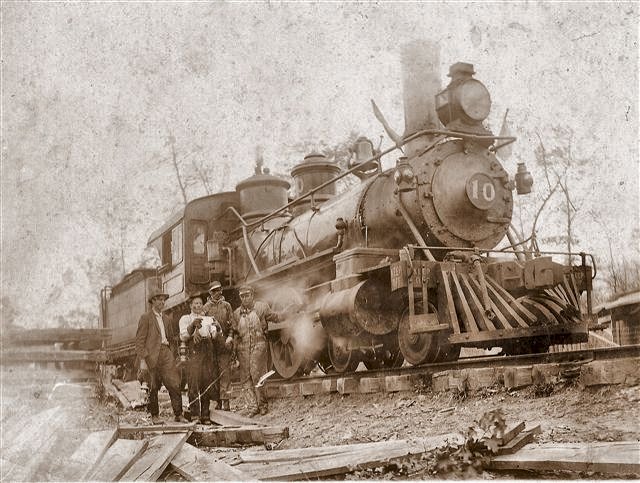 They would not be joining a
wagon train. They heard of a safer kind of transportation which was talked
around in Illinois,
a railroad train. John was forever interested in new inventions and would be
open to these improvements in the future. Martha saucily told John that she wasn’t going
to this God-forsaken place if she couldn’t have music. John figured the family could buy a new pump
organ in the city of Portland upon
arrival. The whole state was not primitive, but
Linn County was, where he, as the head of
the family, had chosen to live. Music was always part of the Thompson heritage.
The pump organ sits in the Waibel home and it contains the original stamped bill
of sale.
They would not be joining a
wagon train. They heard of a safer kind of transportation which was talked
around in Illinois,
a railroad train. John was forever interested in new inventions and would be
open to these improvements in the future. Martha saucily told John that she wasn’t going
to this God-forsaken place if she couldn’t have music. John figured the family could buy a new pump
organ in the city of Portland upon
arrival. The whole state was not primitive, but
Linn County was, where he, as the head of
the family, had chosen to live. Music was always part of the Thompson heritage.
The pump organ sits in the Waibel home and it contains the original stamped bill
of sale.
It would be a long, laborious, frightening trip by wagon to Missouri to find passage on the newest contraption called a steam generated railroad train. It must have been exciting to board on their first train ride. Not many riders had traveled before them. They left bustling Missouri and rode the emigrant train all the way to sunny San Francisco, California, the first step of their new journey. Next they found the only way to reach Portland was either by stagecoach or by boat. They chose boarding a large ship to Portland. Would they get sick on this swaying vessel? Would they have safe travel? What would it be like in Buckhead, later known as Sweet Home?
From Portland to Sweet Home was another journey.
Our family took a steamboat on the mighty Willamette River to a dock in the city of Corvallis. It was then winter and the rain- drenched dirt roads were not able to support a wagon and team until it frosted. They rented a house for a short time, waiting for transportation to their new home. After the hard freeze came they completed their journey. Cousins who had come before them, the Jaspar Riggs family of Foster, came to Corvallis and bundled the new Oregonians into four wagons to finish their long journey. For these weary, excited early pioneers there were many firsts, seeing the Pacific Ocean, riding a train, and, of course the real first: leaving their families for a new life in a lonely part of the United States. How brave these settlers were to come to the isolated mountain community of Sweet Home.
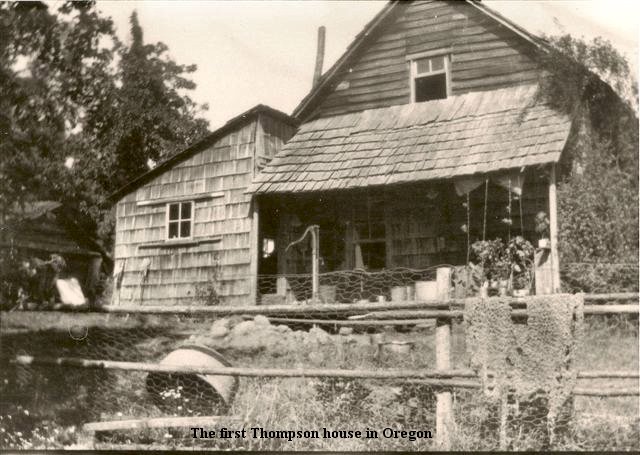 The new family crossed into
town on the wooden planks of the
Ames Creek Bridge. There were a few unpainted
buildings, one livery stable, a blacksmith shop, one saloon with a swinging door
and several small houses sprinkled along the dirt streets. Just a few people
lived in town; mostly they had small farms. It would take some time before this
felt like home to Martha. They arrived with $250 to start a new life. She wasn’t
in Illinois any longer. Martha was
frightened, but she thought about the cherished yellow climbing rose bush they
brought from Illinois and she
smiled. The fragrant yellow blooms are still climbing in the ancient oak tree on
the Waibel home place.
The new family crossed into
town on the wooden planks of the
Ames Creek Bridge. There were a few unpainted
buildings, one livery stable, a blacksmith shop, one saloon with a swinging door
and several small houses sprinkled along the dirt streets. Just a few people
lived in town; mostly they had small farms. It would take some time before this
felt like home to Martha. They arrived with $250 to start a new life. She wasn’t
in Illinois any longer. Martha was
frightened, but she thought about the cherished yellow climbing rose bush they
brought from Illinois and she
smiled. The fragrant yellow blooms are still climbing in the ancient oak tree on
the Waibel home place.
John rented a house on Wiley Creek just east
of town. Soon he found the perfect property he wanted to buy in town, the 4½
acres that he lived on for the rest of his days. The acreage was blooming with wildflowers,
trilliums, lady slippers, and dainty May flowers. This was a sign that he had
made the correct decision. He bought a team of good horses and a milk cow for
his growing family. Horses were
important for transportation, for clearing this newly- found land and also for
planting. John worked long hours and many years making the property in town a
nice place for his family before he built a house and barn. He planted a fruit
orchard, walnut trees and Bing cherry trees all around the property, leaving an
area clear for the fine home he planned to build for Martha. He was puzzled by
the pretty, smelly yellow plant in the swamp. They called it skunk cabbage.
Illinois didn’t have this plant. 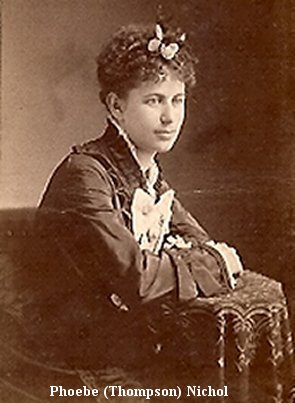
John, a great fiddler, knew he could charge 25 cents for violin lessons. Few people had cash and most paid with fruit, potatoes, onions, venison, or a stack of hay. This gave them food until he took in money from a job. John and his sister, Phoebe played for local dances, usually earned $1 for an evening’s music. John played his fiddle, singing tenor, accompanying Phoebe’s strong, well-trained voice. Together, they were a good pair of musicians.
Later, when the first Pioneer Picnic was held in Crawfordsville, he and Phoebe were the entertainment once more. Their picture is in the Brownsville Picture Gallery. Later John would run a flour mill located near the site of the Weyerhaeuser Mill in Foster. He earned $1 per day for this. They all were getting acquainted with many people who lived in this new town.
Now you might wonder where they had a church. John helped build the first Evangelical church for the families in 1884. The Ames, a Mormon family, gave lumber from their steam-driven sawmill and also land for the church to be built. The men put this together with many hands and it was constructed in record time; now Sweet Home had two houses of worship. Martha did not approve of John playing music for dancing, but as long as he sang in the Sunday church choir, with his fine tenor voice, she never complained about his fiddle playing. Besides, they needed money.
Next a school was needed, and John cut shakes for the Willow Prairie School that sat between the Thompson and Nichols farms just off of Wiley Creek. Phoebe Nichols and her two sons, Andy and Will, both had flaming red hair like their father, and were in need of an education. With the new school, the area began to look more like a community with many things to offer families. Settlers looked on this place as a fine one to begin life anew and raise their children. And so my family did just that.
Martha was busy getting settled with Lettie and excited about having another child. Henry Thompson was born April 23, 1883. He was a healthy child. Florence arrived September 28, 1885. Ethel, the youngest and shortest always, joined the family December 1, 1889. Lettie Pearl, of course, was born in Quincy, Illinois, December 14, 1878. Now Martha was satisfied they had made the right decision, coming to Oregon. Her days were filled with cooking and caring for the children. She also made a quilt block every day of her life, right after reading her Bible which sat on the square table. She could recite the scriptures well. Always a very organized lady, she kept up with all the work that frontier women had to do. She made soap, raised huge gardens and sewed all the clothes mostly by hand with small perfect stitches. Of course, laundry was difficult on a scrub board, especially when she was carrying a baby, but everything was done nearly perfectly.
Soon her sister Margaret Ramer came to stay; she never married after losing her sweetheart who died fighting in some war. Brother Eli Ramer arrived and settled in Crabtree. With brother-in-law Eli at his side, John trapped wild animals for the zoos in large cities. In those days zoos were clamoring for bears, cougars and all sorts of creatures for the city folks to enjoy. The zoos paid them well until the patrons tired of the animals. John dearly loved to change occupations often. Later he and his son Henry would survey the timber claims in the county. John went about the business of making a living in this new town he was beginning to enjoy.
He was a business man. In his Sweet Home career he earned a good living with his fine mind. One of the empty buildings in town was turned into a friendly office where he sold real estate and insurance. His real estate office flourished and he became well known for his transactions. There were many trips to Albany, the county seat, for recording the properties he sold and also recording the many loans he needed for these real estate deals. He speculated on promising properties to make money, borrowing the purchase price from a lender. He also became a notary public. He was a progressive interesting gentleman. Many of the promissory notes were found in John Thompson’s briefcase after his death in 1929. When he wasn’t busy making money, he played cards in the back room with other available gents.
John wrote often to his parents, William and Elizabeth, praising the good life they’d found in Oregon. He assured them there was no problem with the Santiam band of Kalapuya Indians. Most had either died from diseases or had moved onto reservations for their own safety. Previously the starving Indians had stolen food from the settlers who had taken their lands and their seasonal food sources. But no more. The elder Thompsons came to Oregon at the age of 68. Now the Thompson children had grandparents and that made everyone very happy.
William and Elizabeth Thompson bought a small place that they liked on the southern slope of Moss Butte; they spent their final years with their son, John, and daughter, Phoebe Nichols, and their families. Neighbors and new friends of William and Elizabeth were Mealeys, Buchanans, Nichols, Yosts, Billings, Steingrants and the Menears. William and Elizabeth Thompson, my great-great-grandparents, the adventuresome oldsters, were buried in a tiny cemetery on Whisky Butte owned once by the Evangelical Church and later transferred to the Sweet Home Cemetery district. Later in 2007, they were moved to the Gilliland Cemetery.
In 1904 my great-grandfather John Thompson brought the excitement of the first telephone into this community. It took five years for the franchise to be approved. The first telephone was in his home and, as others hooked into the service, the callers needed to go through the switchboard at John’s home, another thing for sweet Martha to manage. I still remember turning the crank on the side of the wooden box and picking up the phone’s receiver and someway making different rings for each home that was connected. This was a true party line, ready to listen to everyone’s calls. Today this first phone is in my daughter’s home on Oak Terrace.
Quiet and sedate Martha Thompson was elected to the city council in 1914. She opposed the frivolity of dancing and felt that liquor was ruining her town. She set out to prevent the drunken brawls by marching into saloons and making a loud disturbance, mostly by beating a drum, just like that famous lady we know. Some of the saloons were run out of business. My great-grandmother Martha was a Bible-packing lady with high principles. She made her mark on Sweet Home, making her community a better place to raise children.
Through the years Grandfather John owned many properties. He had milk cows feeding on some of his property, which is now Strawberry Heights. He milked cows and sold the milk. Many days he would pull a produce wagon into the garden area where he raised beets, turnips, peas, onions and potatoes in large quantities to sell to neighbors. One morning he made his rounds and dug into a gaping hole that contained a large smoking meteorite deep inside. An interesting thing to own and we have it now.
Seven generations of this family have lived on the 4½ acres of the original land that John bought on Oak Terrace. He did build the stately home for Martha with a special swing that the three daughters enjoyed, a swing that young suitors used when they came courting. The house burned in 1935. The home and yard were bordered by Ames Creek and now lie behind the Fire Department. Squirrels collect walnuts from the ancient trees, pesky beavers carve up the cherry trees and opossums and raccoons still roam here. The blending of what was brought from Illinois and what is now present is part of my family’s great heritage. Many of the Thompson descendents continue to live locally.